
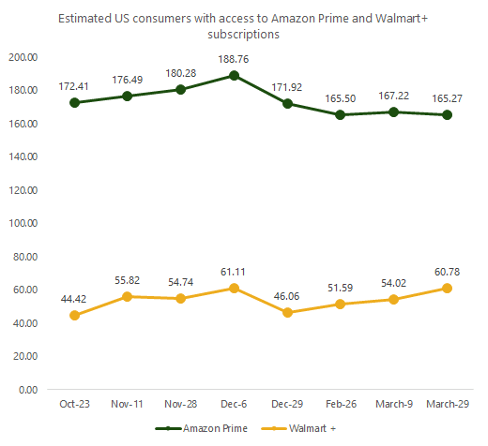
Source: PYMNTS data
In just seven months, the Walmart+ membership program, launched by the world’s largest retailer, has built a base of more than 60 million U.S. consumers subscribed to the $98-per-year service, which provides online delivery, in-store savings and convenience offerings.
Although the total gap between Walmart+ and rival Amazon Prime is still a formidable 100 million members wide, the upstart entry from Arkansas has been trending higher in the first quarter of 2021, at a time when the dominant digital leader has experienced a few months of slippage in its overall share of the category.
According to an exclusive PYMNTS survey of more than 15,500 U.S. consumers between Nov 11, 2020 and April 1, 2021, Walmart+ nearly recouped all of the paid users it shed in December when a spate of free trial memberships expired after the holidays.
At the same time, the number of Walmart+ members using an account paid for by someone else — such as a spouse or a relative — also steadily rose during the first three months of the year, although the share of free trials plunged by 60 percent since setting a near-term high in November.
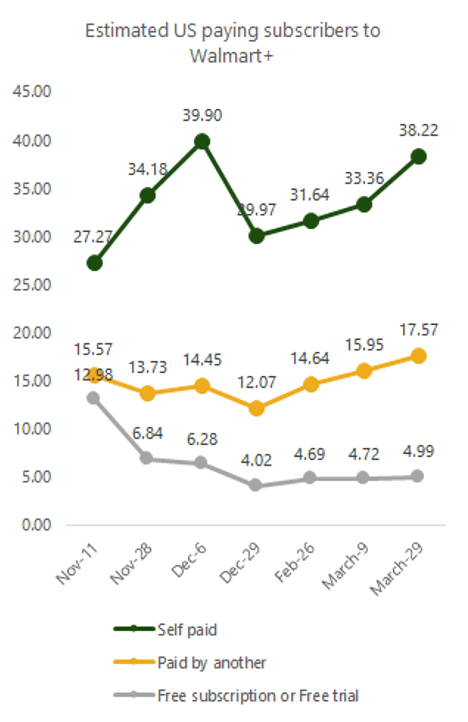
Source: PYMNTS data
By the end of the first quarter, approximately two-thirds of respondents said they had access to Prime versus 24 percent who said they had access to Walmart+. However, from a December peak of 75 percent of consumers having Prime access, the total tally slid 10 percentage points over the past few months to the current 65 percent.
However, as the first chart shows, during that same period, the level of Walmart+ users has rebounded by about one-third from the post-holiday trough, rising from 18 percent in late December to 24 percent by the end of Q1. Since launching Walmart+ in mid-September, the retailer has made it clear that it would be a work in progress, and the company continues to make changes and add new features.
So while Amazon can claim a 100-million-member lead, Walmart can point to the fact that in just four months, that margin has narrowed by roughly 30 million subscribers.
Other Considerations
Like we recently reported, of all eight major retail categories in which Amazon and Walmart compete, the food and beverage space is the one in which the chain store operator most dominates its digital rival — but it is also its single largest source of revenue, accounting for 56 percent.
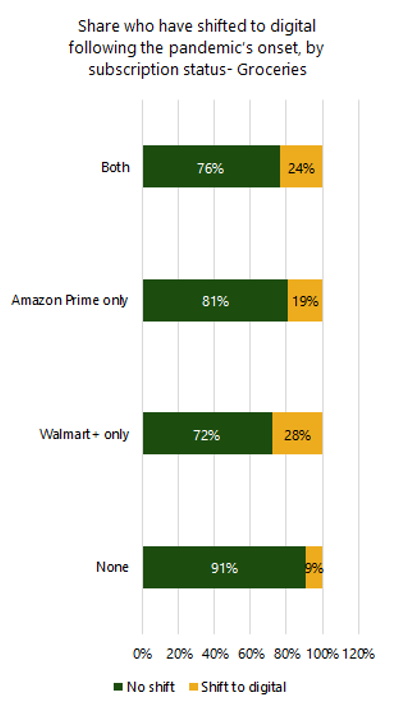
Source: PYMNTS data
With that in mind, one of the key drivers of new subscriptions to Walmart+ is its leadership in groceries, and the convenience that comes with running over 5,000 U.S. stores. In short, the new data shows that when it comes to just grocery purchases, Walmart’s pricing advantage — combined with its in-store and curbside pickup options — are clearly attracting people to its membership program and getting them to shift their behavior. Twenty-eight percent of Walmart+ customers said they made the shift in their grocery-buying during the pandemic compared to about 19 percent of Amazon customers who did.
Combo Subs Rising
Walmart may be winning converts in groceries, but Amazon still dominates in its overall assortment. It’s a shopping dichotomy that is driving an increase in so-called “combo subscribers” who belong to both Prime and Plus.
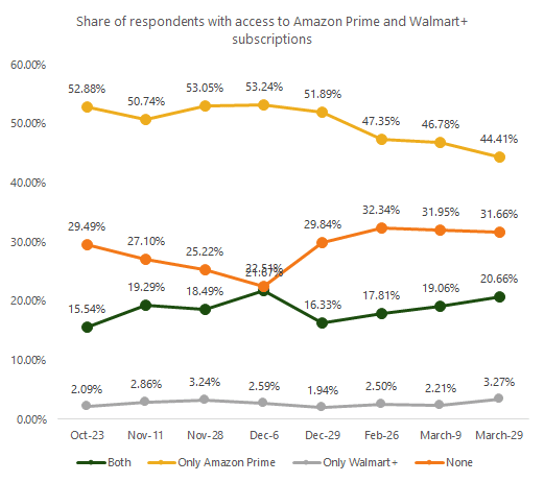
Source: PYMNTS data
As the grey line shows in the attached chart, those who are subscribed only to Walmart+ have inched higher, going from 2 percent to 3.3 percent during the survey period, while Prime-only subs (shown in gold) have steadily fallen from 53 percent to 44 percent.
However, the largest-share growth was seen in the rise of combo-subscribers (shown in green), which increased from about 15 percent to nearly 21 percent over the past five months.
Although Prime offers streaming media and Walmart+ offers discounted gasoline, just over 30 percent of U.S. consumers still do not subscribe to either membership program.
Rural, 30-Year-Old Men
The research also showed that Walmart+ had a slight 5:3 bias toward male subscribers — 30 percent of men and 18 percent of women said they subscribed to the new service, whereas Amazon’s member base was evenly split, with about two-thirds of men and women having a Prime account.
In both cases, Baby Boomers and seniors were the least likely to subscribe, the survey showed — but while Amazon’s demographic range was more consistently clustered with a 55 to 75 percent share of all age groups, Walmart’s bracket-leading millennial subscriber base was about twice as large as its Gen X and Gen Z customers.
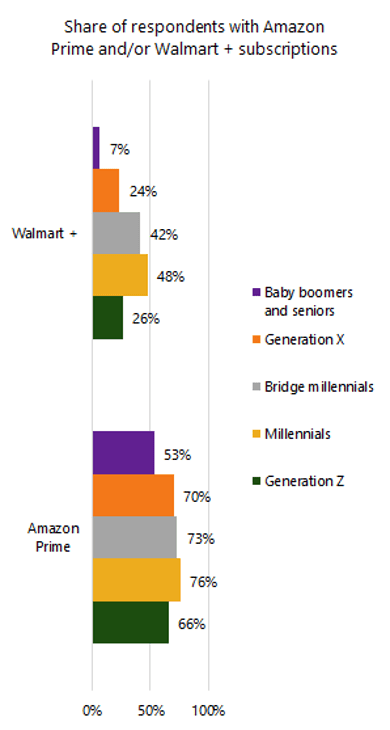
Source: PYMNTS data
In short, Walmart+ subscribers were far more likely to be in the 34- to 41-year-old age brackets compared to the older Gen Xers and younger Gen Zers.
Money and Lifestyle
Although almost 80 percent of Prime subscribers earned more than $100,000 per year, just about two-thirds of them said they lived paycheck to paycheck and struggled to pay their bills, compared to 31 percent of top-tier income shoppers using Walmart+, and only 40 percent who said they had a hard time making ends meet.
As far as lifestyle goes, consumers from large urban areas and cities were most likely to subscribe to one of the membership delivery services, but the gap between urban and rural communities was most pronounced at Walmart, where the spread was roughly 5:1.
Given that 90 percent of Americans live within 10 minutes of a Walmart, this urban subscriber bias is likely an indication that it is still easier and part of the normal routine for rural folks to hop in their car or truck and drive to the closest store.
The discrepancy between Walmart’s unmatched breadth of physical stores and Amazon’s 50-plus percent share of total domestic online retail sales has resulted in each company taking steps to more closely resemble its rival, with Walmart investing heavily in digital and financial services and Amazon buying up and adding physical locations.